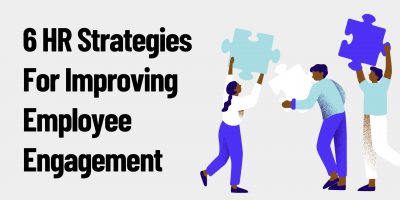
60+ Job Satisfaction Statistics Every HR Professional Needs to Know
Discover the significance of HR software in fostering employee engagement and implementing an efficient employee retention strategy through these job satisfaction statistics.

Engagement, productivity, and retention have one thing in common: they all rely on employee recognition.
It’s the tipping point between a worker’s drive and loyalty vs. their disconnect and turnover.
While many associate it with costly rewards or large-scale programs, meaningful praise doesn’t have to be expensive. Small and consistent gestures can have a far greater impact, especially in times of economic uncertainty, a bad job market, and the lowest employee engagement we’ve seen in the last 10 years.
From a handwritten “thank you” note to a team-wide shoutout, low-cost employee recognition ideas often have the highest returns.
Let’s explore these small acts of appreciation and how making them part of the work culture can create a lasting outcome.
Recognition fulfills a basic human need for appreciation.
This intentional act can take many forms in the workplace, from verbal praise to physical employee rewards. The goal is to make employees feel seen and valued, reinforcing their positive behavior.
Studies consistently show that those who receive regular praise are more satisfied with their jobs.
In fact, a recent one from Gallup and Workhuman, The Human-Centered Workplace: Building Organizational Cultures That Thrive, confirms that employees who receive high-quality recognition are more connected to the organization and more likely to stay long-term.
The study also shows that in 2024, senior leaders were 50% more likely to say employee recognition is important at their company than two years prior.
But despite this progress at the top, most employees still aren’t feeling it: only 22% said they get enough recognition for their work.
This gap between what leaders believe and what employees experience is a sign that recognition needs to happen more often and more meaningfully. Failure to address it can be a missed opportunity to capitalize on the performance gains from an engaged, motivated workforce.

While recognition may feel personal, its effects are measurable. From engagement scores to turnover rates, the data tells a compelling story.
The research by Gallup and Workhuman, which we referenced earlier, highlights a clear business case for employee recognition. With 51% of the workforce actively looking for new jobs, the turnover risk is a growing and costly concern.
However, their data also shows that 42% of employee turnover is preventable, and well-recognized employees were 45% less likely to leave within two years.
The same research also identifies five pillars of strategic recognition: fulfilling expectations, authenticity, personalization, equity, and integration with company culture.
Workers are nine times more likely to be engaged when companies meet at least four pillars. Even if recognition meets one criterion, engagement still increases 2.9 times.
Another Gallup and Workhuman research shows that recognition is as good for culture as for business.
Employees who feel that recognition is a key part of their company’s culture are 3.7 times more likely to be engaged and nearly half as likely to experience frequent burnout than those who don’t.
Finally, the results found that if a company with 10,000 employees doubled the number of people who felt genuinely recognized at work each week, the increase in productivity could save the company nearly $92 million.
Considering that some of the best employee recognition ideas are often low-cost or free, this return on investment is both significant and surprisingly attainable.

Most employees expect fair compensation, as it’s a baseline requirement.
A good paycheck, regular pay raises, or performance bonuses reward them for their time, skills, and output. However, once that need is met, compensation alone is no longer a primary driver of motivation or loyalty.
That’s when recognition takes over, acknowledging the individual, including the effort, values, collaboration, and innovation they put into their work.
It’s immediate, personalized, and often doesn’t require budget approvals or fiscal planning. In fact, some of the best employee recognition ideas are free or low-cost, from a verbal “thank you” or a handwritten note to a public shoutout.
So, while compensation is transactional, recognition is emotional.
Doug Crawford, Founder of Best Trade Schools LLC, illustrates: “Paychecks handle bills; appreciation keeps people in.”
Crawford further explains, “Compensation is the deal. You do the work, and you get paid. But that’s just the baseline. People want to feel like what they do matters.
They want to know someone noticed the effort, not just the result.”
Despite their difference, the bottom line is that these two should work together, not as substitutes but as complementary tools. Employers who understand this balance are better positioned to build motivated, loyal, and high-performing teams.
Companies with formal employee recognition programs experience 31% lower voluntary turnover and are 12 times more likely to achieve strong business outcomes than those without a program. (Quantum Workplace, 2024)
Exploring the business case for recognition shows a measurable impact on engagement, retention, and workplace culture.
But beyond the numbers, building a culture of appreciation means making recognition an intentional, consistent part of an organization’s operations.
“As a workplace culture expert, I’ve discovered that the most powerful employee recognition strategies often cost very little, if anything at all,” explains Melissa Williams, CEO at LDN.
Williams believes that successful recognition isn’t about large budgets but about establishing a foundation of psychological safety and demonstrating emotional intelligence.
“This means recognizing employees’ value beyond compensation, aligning employee recognition with clear goals for the individual, team, and entire operation, and celebrating progress at all levels, not waiting for big wins.”
Although this process begins with leadership through commitment, alignment, and consistency, its success depends on buy-in from every level of the organization. Managers should regularly recognize team members and encourage peer-to-peer appreciation for better inclusion and connection across teams.
Recognition must also feel personal, not performative, to truly resonate.
Therefore, authentic appreciation starts by understanding individual preferences.
Tools like personality assessments or simple pulse surveys can help reveal what matters most to each individual. Just as important, recognition should align with the company’s values, reinforcing the behaviors and outcomes that support its mission.
With these foundations in place, the following employee recognition ideas on a budget offer practical ways to make appreciation a meaningful part of everyday work.
You don’t need a big budget to show your appreciation.
Small gestures can have just as powerful an impact when they feel personal and timely.
The following low-cost or no-cost suggestions are thoughtful and practical. When aligned with employees’ preferences, they can make the workforce feel genuinely seen and appreciated.



Recognition is as effective as its relevance to the workers receiving it, big budget or not.
The following creative employee recognition ideas show that despite the environment, it takes a little to ensure no one feels overlooked, no matter where they are.
Another paramount distinction is tailoring recognition based on the employee journey.
By aligning ideas for employee recognition to their respective career stages, employers show that they truly see their workers, not just for what they do but for their potential and future contributions.
Fun means memorable.
Turning away from the generic (but efficient) incentives and adding creativity to recognition can create distinctive experiences that build long-term emotional connections.
These fun employee recognition ideas can also strengthen company culture, as they have the potential to reinforce shared values, leave a lasting impression, and create memorable stories employees are likelier to share.
Dedicate a day to fun-themed virtual or in-person activities paired with recognition and team games to make appreciation feel like a celebration, not a checkbox.
Turn recognition into a shared moment by having employees tell the story behind a teammate’s win. This adds depth and emotion and makes achievements more relatable and fun.
Make a once-a-month surprise gift tradition for the highest-performing employee. The mystery element adds excitement and turns recognition into a fun experience.
Feature employees with a fun caricature, title, and short accomplishment description. This strategy adds personality and keeps recognition visible and creative.
Create a tradition with a themed trophy that gets passed weekly or monthly to standout employees. It’s low-cost, creates anticipation, and builds a playful sense of pride and camaraderie.
While fun recognition initiatives can be an excellent cost-free way to enhance engagement and reinforce appreciation, it’s crucial to acknowledge that not all employees will respond to them the same way.
What may be enjoyable for some could feel awkward or inappropriate to others.
For this reason, employers should implement these ideas thoughtfully and sensitively to individual preferences and cultural norms.
An idea without a plan is a missed opportunity.
According to Nectar data, only 52.6% of employers have recognition programs.
Yet, these structured programs indicate a clear value: 92% of workers in companies with a recognition program feel appreciated, compared to 70% in companies without one.
So, how do you turn an employee recognition idea into a reality?
Bridging this gap requires a multiple-step implementation process based on a strong foundation and a clear strategy.
Step one is to define the framework.
An employee recognition program policy should outline the program’s goal and purpose, the types of behaviors that will be rewarded, how, who can give recognition, how often it should occur, and more.
Step two involves gathering data.
Listening to employees is just as important as setting objectives. Involving the workforce in the planning process through surveys, focus groups, or informal feedback can reveal the most appreciated rewards and incentives.
A program built around individual preferences will likely gain traction and feel more authentic.
Step three is company-wide implementation.
Use employee recognition software to automate the implementation.
These tools bring structure and consistency by incorporating recognition into everyday routines, automating rewards, and encouraging participation from all levels. They also provide valuable insights that help track effectiveness and adjust the program.
Step four requires clear communication.
Once launched, a recognition program needs clear communication, leadership alignment, and training at all levels. It should also be visible and inclusive across departments and work environments.
Step five involves evaluating and refining the program.
Finally, recognition is not a one-time effort.
The most impactful recognition programs are regularly reviewed, measured, and adjusted. This continuous effort ensures they remain adequate, relevant, and aligned with employee needs and company goals.

In the pursuit of rewarding employees without money, the broader impact of recognition must not be overlooked.
Although non-monetary rewards can be effective, genuine employee engagement is driven by consistent, meaningful appreciation.
In that sense, some of the most common mistakes to avoid include:
One last tip before getting started is that recognition doesn’t have to be expensive, but it must be employee-focused.
A well-thought-out employee recognition plan can be effective and budget-friendly if its purpose goes beyond driving company profit or ticking a box. Instead, it should focus on the individual and understand their needs, preferences, and expectations.
By adopting this mindset, even the simplest employee recognition ideas can drive long-term results.
Disclosure: Some of the products featured in this blog post may come from our partners who compensate us. This might influence the selection of products we feature and their placement and presentation on the page. However, it does not impact our evaluations; our opinions are our own. The information provided in this post is for general informational purposes only.
Content Writer at Shortlister
Browse our curated list of vendors to find the best solution for your needs.
Subscribe to our newsletter for the latest trends, expert tips, and workplace insights!

Discover the significance of HR software in fostering employee engagement and implementing an efficient employee retention strategy through these job satisfaction statistics.

What makes a gift memorable? These low-cost employee appreciation gift ideas show that recognition means more when it’s personal, authentic, and meaningful.

Why do some teams with identical resources dramatically outperform others? The answer lies in the often-overlooked interpersonal dynamics that can make or break workplace collaboration.

Transform your workplace with HR strategies designed to boost employee engagement, drive productivity and job satisfaction, and foster a culture of growth and success.
Used by most of the top employee benefits consultants in the US, Shortlister is where you can find, research and select HR and benefits vendors for your clients.
Shortlister helps you reach your ideal prospects. Claim your free account to control your message and receive employer, consultant and health plan leads.